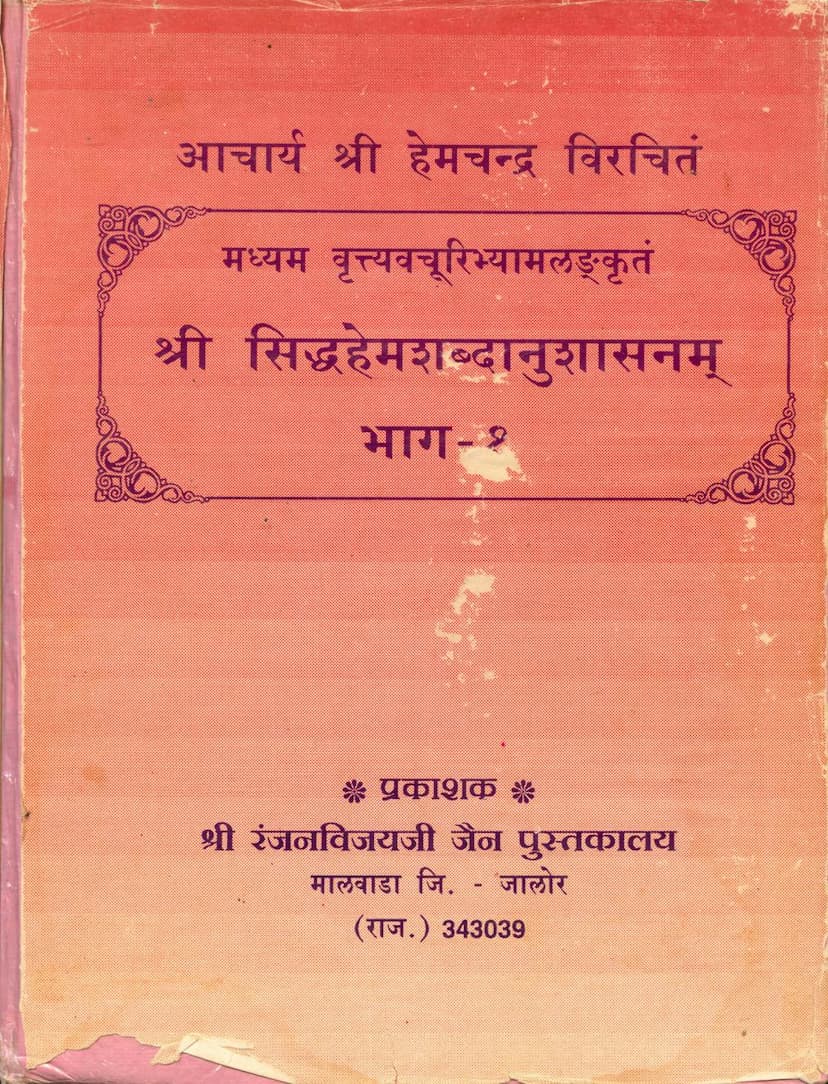Madhyam Vrutti Vachuribhyamlankrut Siddhahemshabdanushasan Part 01
Added to library: September 2, 2025

Summary
Here's a comprehensive summary of the Jain text "Madhyam vrutti vachuribhyamlankrut Siddhahemshabdanushasan Part 01," based on the provided pages:
Title: Madhyam vrutti vachuribhyamlankrut Siddhahemshabdanushasan Part 01 (Shri Siddhahemshabdanushasan, adorned with Madhyam vrutti and Vachuri, Volume 1)
Author(s): Acharya Shri Hemachandra (original work), Kshamabhadrasuri (first editor), Ratnajyotvijay (re-editor), Ratnakar Surishwarji Maharaj (inspiration), Suryaprabha Shri Ji (inspiration), So. Sa. Sa. Shri Saubhagyashriji (inspiration).
Publisher: Shri Ranjanvijayji Jain Pustakalay, Malwada, Dist. Jalore (Raj.), India.
Overall Purpose: This book is the first volume of the highly revered Jain grammatical text, Shri Siddhahemshabdanushasan, authored by the great scholar Acharya Hemachandra. The text is presented with the "Madhyam Vritti" (Medium Commentary) and "Vachuri" (detailed commentary/explanation), making it accessible and comprehensive. It aims to preserve and propagate the knowledge of Sanskrit grammar, which is considered fundamental to understanding ancient Indian culture and Jain scriptures.
Key Themes and Content:
-
Praise and Dedication: The initial pages express reverence for gurus and blessings from prominent Jain Acharyas, indicating the spiritual and scholarly significance of the work. The book is dedicated to Acharyadev Shri Rajendrasurishwarji M.S. for his pivotal role in restoring the Kalikund Tirth.
-
Importance of Grammar (Vyakarana): The text emphasizes the crucial role of grammar as the foundation of language. It highlights Sanskrit grammar as being superior due to its detailed derivation of words from their roots. Understanding grammar is presented as essential for comprehending the essence of ancient Indian texts, which are primarily in Sanskrit and Prakrit.
-
Acharya Hemachandra's Siddhahemshabdanushasan: The summary recounts the creation of Siddhahemshabdanushasan by Acharya Hemachandra at the request of King Siddharaj. Though a large portion of the original work was lost, the "Laghu Vritti," "Madhyam Vritti," and "Brihad Vritti" are still extant. The "Madhyam Vritti" is considered ideal for students with moderate intellectual capacity, as the "Laghu Vritti" may lack comprehensive integration, and the "Brihad Vritti" might be too advanced.
-
The Role of the Current Edition: This particular edition is a re-publication, aiming to address the increasing demand for the text. It clarifies complex or doubtful sections by consulting other commentaries and manuscripts. The first part of this edition covers the first chapter, comprising four "Padas" (sections).
-
Content of the First Chapter (Prathama Adhyaya): The table of contents (Page 5) indicates that the first chapter is divided into four "Padas," likely covering fundamental aspects of Sanskrit grammar. The detailed breakdown on pages 8-24 shows the commencement of the grammatical exposition:
- Introduction and Invocation: The text begins with salutations and the opening verse by Acharya Hemachandra, explaining the structure and purpose of the grammatical work.
- Classification of Sounds and Letters: Pages 10-11 delve into the classification of vowels (swaras), their duration (hrasva, deergha, pluta), named vowels (nama), diphthongs (sandhyakshara), anusvara, visarga, and consonants (vyanjana).
- Grammatical Concepts: Subsequent pages introduce concepts like Kadiviryanjana (consonants from K to H), classification of consonants into Varga (classes), pronunciation based on place and effort (Sthanaprayatna), grammatical categories like vibhakti (case endings), pada (word) formation, and the significance of "svamjnasangya" (technical terms).
- Specific Grammatical Rules: The detailed breakdown reveals discussions on various phonetic and grammatical rules, including sandhi (combination of sounds), changes in letters, noun formations, verb conjugations, and the application of these rules to specific words.
-
Commitment to Knowledge Dissemination: The publication is noted to be printed from "Gyan Dravya" (funds dedicated to knowledge), implying a charitable or religious motivation to make this valuable text available.
-
Inspirational Figures: The text acknowledges the inspiration from Swargiya Sadhvi Ji Shri Suryaprabha Shri Ji, highlighting the collaborative effort in bringing this edition to light.
In essence, this book is a scholarly and devotional presentation of Acharya Hemachandra's foundational grammar work, Siddhahemshabdanushasan. It serves as a crucial resource for Jains and scholars interested in the intricacies of Sanskrit grammar and its application within the Jain tradition.